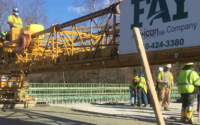Maryland is pushing forward a plan for a public-private partnership team to design, build, finance and operate new express lanes on a key highway interchange in its Washington, D.C. suburbs, estimated to cost between $9 and $11 billion, while it has yet to resolve a high-profile rail line P3 stalled over disputed costs.
Four infrastructure development teams have submitted qualifications to bid on the Maryland Dept. of Transportation’s plan to add privately financed express lanes on portions of the Capital Beltway and I-270 corridor in suburban Montgomery County.
Vying to design, build, finance and operate the express lanes in exchange for a 50-year toll revenue concession are:
Accelerate Maryland Express Partners, with lead developer/equity Itinera Infrastructure & Concessions; lead contractors Halmar International and Itinera and designers Atkins North America and Gannett Fleming.
Accelerate Maryland Partners, with lead developer/equity Transurban (USA) Operations and Macquarie Infrastructure Developments; lead contractor Archer Western Construction; and designers Dewberry Engineers and Stantec Consulting Services.
Capital Express Mobility Partners, with lead developers/equity Cintra Global, Meridiam Capital Express and John Laing Investments Ltd.; lead contractor Ferrovial Agroman US and designer AECOM Technical Services.
Potomac Mobility Group, with lead developer/equity ACS Infrastructure Development; lead contractor Dragados USA; and designers Parsons Transportation Group, Jacobs Engineering Group and HDR Engineering.
Approved by Maryland’s Board of Public Works in January, the plan calls for adding up to four tolled express lanes on a five-mile section of the Beltway, crossing the Potomac River to connect with northern Virginia’s Express Lane system.
The I-270 express lanes would begin with a 9-mile section between the Beltway and I-370 in Gaithersburg, then continue another 32 miles to I-70 in Frederick after the other projects are completed.
Also included is replacement of the American Legion bridge, opened in 1962, which carries the Beltway across the Potomac River to Virginia. Estimated to be a $1-billion project, work also will be funded by Virginia, in a bi-state agreement reached last year.
MDOT and the state Transportation Authority, which oversees Maryland’s tolled highways, expect to announce a shortlist of qualified teams in July, with formal proposals to be submitted in early 2021.
Selection of a preferred development team could come by mid-year, with design and construction getting underway following a federal environmental record of decision.
Concurrent with the P3 solicitation process, Maryland is performing environmental studies to evaluate options for building managed lanes in both the Beltway and I-270 corridors. MDOT says the draft EIS containing results of the studies will be published soon.
“As we plan for recovery, these critical infrastructure projects are key to rebuilding our economy and keeping the supply chain moving,” said Gov. Larry Hogan. “It is great to see leading international firms interested in investing in the ... region."
Transportation Secretary Greg Slater added that “partnering with the private sector is key to delivering for the businesses and residents of Maryland in the months and years to come."
Meanwhile, uncertainty continues to shroud Maryland’s other major P3 initiative, the $2-billion Purple Line light rail transit line, with project work now halted as state officials and the project design-team dispute schedule and cost overruns.
On May 1, the Fluor-led Purple Line Construction Partners design-build team announced its intention to withdraw from the project, citing its inability to resolve the long-running disagreement over responsibility for the delays and added expense.
Fluor is also a partner in the development consortium overseeing the Purple Line’s design, construction and operation under a 36-year concession with the state.
Although the design-build team is more than a month into its planned 60- to 90-day transition period, which includes securing and vacating worksites along the Purple Line’s 16-mile route, ongoing negotiations with Maryland transportation leaders may ultimately keep the contractor on the job.
In a brief June 2 agency statement, Slater and Purple Line Construction Partners CEO Peter van der Waart expressed satisfaction with progress made toward reaching an equitable settlement.
If the design-build team remains on the project, a new hurdle has emerged in the form of an appeal to a federal judge’s April decision to dismiss a lawsuit challenging the Purple Line’s environmental permits.
Briefs in the case are set to be filed in the U.S. federal appeals court in Richmond, Va., this summer.



